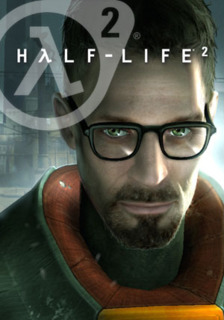Half-Life 2 is destined to be remembered as one of the greatest shooters of all time.
Half-Life 2 pickups where Half-Life left off, although no-one is entirely sure what time has passed since the events of the first game. At the end of the first game the Gman gives you a decision and neither choice’s consequences are clear at that time. During the opening sequence of Half-Life 2 the Gman reappears and calls on you to be “the right man in the wrong place” and you simply appear on a train and begin the game. Throughout the game you will notice some creatures you once fought now appear friendly and helpful. Subtle nuances like this create a believable displacement for you as the character Gordon Freeman.
Most of Half-Life veterans will feel slightly disoriented with the story and members of it (mostly because there were only two scientist models in the first game). Therefore Dr. Kleiner and Dr. Vance will be largely unfamiliar as individual people, even though they both mention specific instances in the early portion of the game. For instance Dr. Vance was the black scientist that told you to go for help in the first game and Dr. Kleiner was the scientist in charge of the experiment that resulted in the resonance cascade. Not to mention Barney, who was EVERY security officer in the first game, returns as a singular character in Half-Life 2.
It’s safe to say that some time has passed since you resurfaced within City 17. Another missing gap in the story is exactly where City 17 is in relationship to Black Mesa and who exactly Dr. Breen is. These all get revealed over time, but it leaves something to be desired within the first couple hours of playing the game.
Noticeable immediately after the Gman stops talking with you is the technological strides made with the Source Engine. Everything looks and feels incredibly realistic. Most noticeably with the Source Engine is the attention to imperfections that give Half-Life 2 its most realistic aspect. Things like concrete and plastic have dents and other various defects that you see in common items like soda cans and trash bins, which extremely convincing. Other small noticeable details like dirt and smears are extremely obvious when you get placed into an urban environment.
One great change to the first person shooter genre that Half-Life introduced and Half-Life 2 builds upon immensely is the in-game music. Unlike most “epic” shooters with orchestral scores done by symphony orchestra. Half-Life 2 settles for nothing less than suitable slow and heavy metal during action and chase sequences throughout the game. These heavy metal pieces inspire a sense of action and tension in the scene that wouldn’t be possible with classical music.
The ending to the game remains much the same as the first one. After what seems like a victory against all odds the Gman appears and extracts you. He also makes note of telling you he has received many offers for your services, and that further assingments will follow. His history and employers remain a mystery.
If it’s the story, the graphics, or the believable environments that will ultimately get you to try Half-Life 2, I can tell you with certainty that you will be overwhelmed by how immersive this game is. From the vehicle chases to scaling the Combine Citadel there's no arguing that Half-Life 2 is destined to be remembered as the greatest shooter of all time.

